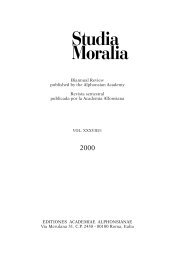Avant-propos - Studia Moralia
Avant-propos - Studia Moralia
Avant-propos - Studia Moralia
You also want an ePaper? Increase the reach of your titles
YUMPU automatically turns print PDFs into web optimized ePapers that Google loves.
THE BASIC GOODS THEORY AND REVISIONISM 173<br />
mental importance of this relationship as well. 5 Ecclesiology is<br />
central to how one comprehends Tradition and the role and<br />
function of the magisterium in relation to the theologian and the<br />
faithful.<br />
Since Vatican II, theologians have generally adhered to two<br />
fundamentally different ecclesiological models. The model that<br />
originated in the Middle Ages and predominated up until Vatican<br />
II is the hierarchical model. According to this ecclesiological<br />
model, knowledge flows downward from the magisterium to<br />
theologians to the faithful. The role and function of theologians<br />
in this model is to explain and clarify to the faithful what the<br />
magisterium has taught authoritatively, but not to question or<br />
challenge those teachings. 6 While the sensus fidelium and their<br />
experiences are a source for informing the magisterium in its<br />
formulation of moral teachings, it is the magisterium’s responsibility<br />
to determine how that experience is to be interpreted and<br />
incorporated into its teaching. In cases where there is a disparity<br />
between human experience and magisterial teaching (e.g., artificial<br />
birth control), the magisterium holds the trump card. According<br />
to this model, then, the magisterium is the final authority<br />
for interpreting, formulating, and dispensing moral teachings.<br />
Theologians help to explain and disseminate those teachings<br />
to the faithful. They should not question or challenge authoritative,<br />
non-infallible teachings where the magisterium has<br />
deliberately stated an opinion about a controverted matter, even<br />
if their scholarship challenges it, but should defend and explain<br />
such teachings. If we think of this ecclesiological model as a<br />
pyramid, the magisterium is at the pinnacle of the pyramid and<br />
is the hermeneutical key for all other sources of moral knowledge.<br />
With Vatican II came a profound transition in ecclesiology<br />
and, by implication, moral epistemology. The <strong>propos</strong>ed concentric<br />
model is referred to as the people of God or communio<br />
(communion) model. 7 Within this model, knowledge is dis-<br />
5<br />
GRISEZ, Christian Moral Principles 831.<br />
6 This model is clearly reflected in PIUS XII’s Humani Generis (see, for<br />
example, DENZINGER, 2313-14).<br />
7<br />
MCCORMICK, Critical Calling 40. For a helpful study on communio as an<br />
ecclesiological model, see JEAN-MARIE ROGER TILLARD, O.P., Church of Church-

















